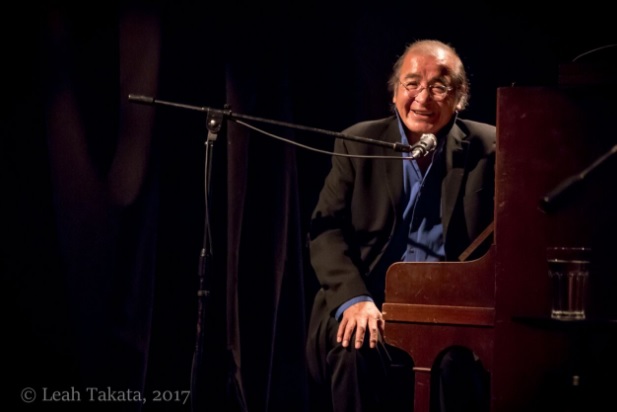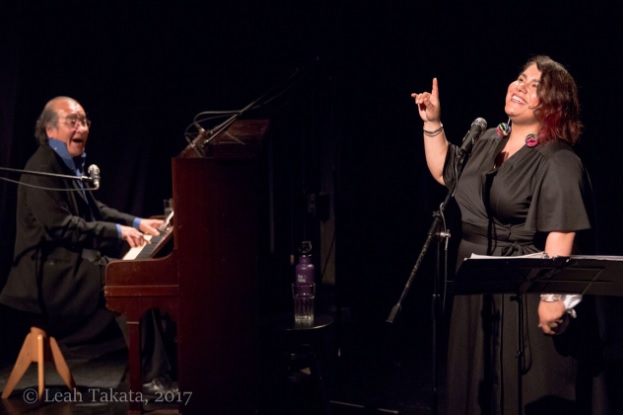Although Tomson Highway (born 1951) may be a lesser known name in Czech literary circles, or even European for that matter, he is one of Canada’s most influential voices. An Aboriginal Canadian playwright, novelist and composer, Highway has received numerous awards celebrating his work, including the Order of Canada in 1994 in recognition of his services to the nation. 2017 being Canada’s 150th anniversary, this was a particularly exciting occasion as Highway came to Prague - the first stop on his European tour - to perform at Kampa Theatre, and to give a talk at the Faculty of Arts the following day. The event which took place on April 23 and 24 was a collaborative effort between the Department of Anglophone Literatures and Cultures at Charles University and the Canadian Embassy in Prague, and was equally educative and entertaining as a result. 
At the Sunday evening performance Highway was accompanied by singer Patricia Cano and saxophonist Marcus Ali, who together delivered a stunning ten-song set in cabaret style to a packed out auditorium. On Monday morning the complimentary lecture provided a greater insight into Highway’s personal experience as a First Nations artist, this community’s marginalised ideology, and a quick lesson in Cree - his native tongue. What characterised both events was undoubtedly Highway’s infectious humour; he is a charmingly endearing individual, who creates a jovial atmosphere within which to discuss seriously these subjects without ever losing the attention of the listener.
Dr Klára Kolínská from the Department of Anglophone Literatures and Cultures of the Faculty of Arts introduced Highway as a ‘living legend’ and a ‘revolutionary’ in the Canadian theatre scene, praise which the writer accepted with humble graciousness before introducing himself in his own humorous manner (indeed, the one in which he seems most comfortable), as the son of a widely celebrated Caribou hunter, and of a Caribou no less! This tongue-in-cheek comment was made passingly, but received great laughter; as is the case with many of Highway’s quips; a quiet delivery masks his sharp wit, and so the jokes just keeping coming.
He describes his childhood as one of a Prince; surrounded by 500 lakes, the “unique landscape” of North Western Manitoba has clearly left a permanent impression on the artist, and he regaled us with anecdotes of his family life. As the 11th of 12 children, having 48 aunts and uncles, and consequently over 1000 cousins, Highway sees himself as “the world’s richest man in love”. Whilst assumptions are often made about the poverty and deprivation of First Nation communities and familial life, he countered this negative perspective, noting that “You never hear about the positive stuff”. Rather, he sees himself as incredibly privileged to have been surrounded by such an abundance of love, for the opportunities this provided him with, and for having his interest in languages ignited at such as young age. 
Indeed, the focus of his talk soon turned to language, an incredibly significant aspect of identity in any culture, but perhaps even more so for one so underrepresented globally. Highway grew up in a bilingual community where both Cree and Dene were spoken, and through exposure to Catholicism he also learnt Latin from a young age. The pride in his linguistic skill is evident, particularly in respect to Cree; we were treated to a rapid demonstration of the speed and complexity of the language, one which he deems “the most living”, even “blooming”. He then gave us a broad overview of the various linguistic families of Canadian First Nation communities, drawing comparisons with Slavic and Germanic languages to highlight their complexity and disparity. Having lived in France for 13 years, and thus speaking French fluently, Highway gave valuable insight into the implications of gendered languages, a category which Cree does not fall into. This was then linked to a more ideological perspective which made for interesting cultural comparisons.
Highway posited that mythology is inherent within language; as such, English has historically established a hierarchical structure which positions ‘he’ as superior to the extreme opposite of ‘she’. In contrast, Cree is a circular language, which oscillates freely between genders and also between the ‘animate’ and ‘inanimate’, the soul or spirit being reflected in the word. Highway logically went on to explain that in Cree the only body parts linguistically animate are the female genitalia, and as a consequence they have a cultural importance equivalent to God in the English hierarchy: as he joked, “if thou father art in heaven, where’s your mother?” This pantheistic mythology has created a cultural map for the community, a guide through the universe which (as Highway dropped in) has persisted for around 60 000 years. He noted one cultural battle ensuing from Columbus’ arrival in America in 1492 was that “God met his wife” - and he didn’t like it. This relatively recent history of colonialism and its introduction of Catholicism to First Nations communities may have attempted to quash the pre-existent mythology, but Highway sees his task as an artist as re-illuminating it for a contemporary audience, both locally and globally. 
Having been part of the first wave of Native writers, and now nearing on retirement, Highway bestows an imperative responsibility to the next generation of artists to continue rekindling knowledge and pride in First Nation culture. Although he will undoubtedly continue to write and perform, and his work will continue to be celebrated, he acknowledged “I’m tired, and I’ve done my share.” He sees the pressures of an increasingly troubled world as a common humanitarian responsibility, speaking specifically about climate change as a catalyst for action, and noting that art and performance is just one force to be utilised in changing perspectives. Highway left much to contemplate, and it was only a shame the lecture wasn’t longer - his next performance in Warsaw demanded his departure, but, as graciously as he had begun, he thanked us for our attendance and promised to treasure our laughter for the rest of the day. The success of this collaborative event cannot be understated, and it is to the credit of all involved that such an enthusiastic response was received.














